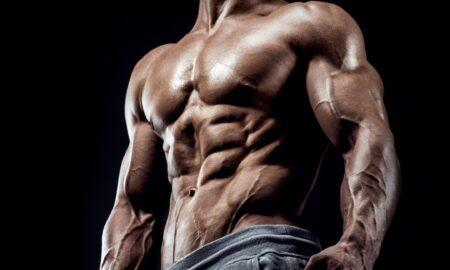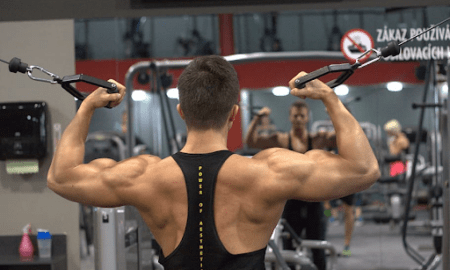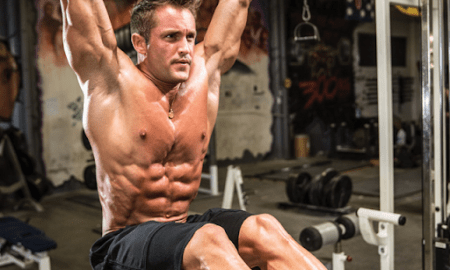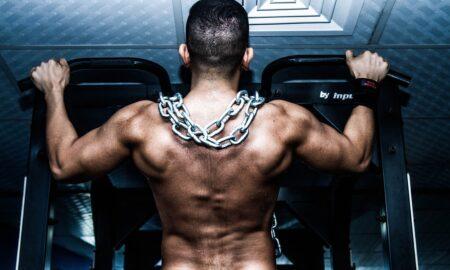There’s something about a ripped set of abs that grabs onlookers by the throat and rivets their eyeballs. Sure, big arms get a few lingering glances and can make some women’s hearts skip a beat, but there’s no comparison to a chiseled midsection. Awesome abs can put ladies into a trance as they sigh, ‘Oh, can I touch those?’those being your rolling ripples of rock-hard ruggedness. (What did you think I was talking about?). Hell, you can have big arms, but if they’re hanging next to a bloated belly, you won’t get the longing looks that a tight midsection attracts. Even in clothes, all bets are off. The abs have it.
So you didn’t need convincing that your midsection has the power to attract the opposite sex like a shiny new Porsche (well, almost). You say you need information on how to get your abs to stand out in bold relief, like dense boulders of polished granite, even when you’re standing relaxed? Let’s start by exploding a few myths so you can speed toward that six-pack (and the first step is to get your mind off beer).
Myth 1: The abs are a bunch of knotted muscle masses. Actually, what’s commonly known as the abs is one muscle, the rectus abdominis. It runs from the bottom of the ribcage down to the pelvis. The reason it looks like a six-pack of muscles is that vertical and horizontal tendons create sections. The tendons are the dividing lines you see’well, maybe you don’t see ’em yet, but you will soon!
Myth 2: You need to do hundreds of reps to get great abs. Wrong! The rectus abdominis is a muscle like the biceps, pecs, delts and so on. To get a deep, etched midsection, you have to build it. Yes, I said build, but don’t panic. You won’t get a peaked paunch from a belly full of muscle because the rectus abdominis is relatively flat, and it’s held tightly by those tendons mentioned above. Nevertheless, to get those tendons to sit deeper so you have unmistakable delineation, you have to build enough ab muscle that it rises above the tendons. And how do you build muscle? With progressive resistance’adding weight to your ab exercises whenever possible’and getting eight to 20 reps per set.
Myth 3: For best results train your abs every day. Nope. Again, the rectus abdominis is a muscle just like chest, lats and so on. If you train your abs intensely through a full range of motion, they need rest to recover and regenerate. Never train abs more than three nonconsecutive days a week’and two may be better if your intensity is high.
Myth 4: The crunch is the best abdominal exercise. That’s like saying the leg extension is the best quad exercise. Sure, it isolates the target muscle, but most bodybuilders know that isolation exercises aren’t the best movements for adding muscle. In the quads’ case that means squats and leg presses. As for the abs, a recent EMG study showed that even the bicycle exercise, pedaling your legs in the air while you’re on your back, provides more electrical response, or fiber activation, in the rectus abdominis than the flat crunch. Why? Muscles are designed to function best in tandem with other muscles, and with the abs that means bringing in the hip flexors. Other exercises that provide muscle teamwork are hanging kneeups, incline kneeups and incline situps. Of course, if you do those exercises with momentum, throwing your torso or legs through the air on every rep, then they become inferior to the strict crunch. You have to stay in complete control to get the best ab-etching effects.
Myth 5: The standard crunch is a full-range exercise for the rectus abdominis. If you’re doing crunches on the floor or a flat bench, you’re only training the top two-thirds of the abs’ range of motion. To train the other one-third of the stroke, your back has to arch 30 degrees to the rear of center to place your rectus abdominis in its stretch position. Your upper torso can’t move down through the floor, so you have to do the crunch exercise with low-back support that allows your upper torso to arch back. That’s the premise behind the Ab Bench, with its rounded back pad. The cable pulls your back over the pad, so your low back is slightly arched and your rectus abdominis is stretched. From there you can pull forward into a crunch and get a total ab contraction. Almost everyone who tries a full-range crunch on an Ab Bench can’t believe how different the exercise feels from the standard crunch. It’s all in the stretch. Also, the Ab Bench makes it a lot easier and more comfortable to add weight as you get stronger.
Remember, you’re after progressive resistance to build muscle. If you don’t have an Ab Bench, you can simulate the exercise with cable crunches done with low-back support. Have a partner put his or her hand on your lower back so you can get a slight lower-back arch and a stretch on every rep, or do your cable crunches sitting backward on a preacher bench with the pad set low for lower-back support.
Myth 6: Leg raises done on the end of a bench are one of the best ab exercises. From the above discussion on muscle teamwork, you might think leg raises would provide muscle teamwork and plenty of rectus abdominis stimulation, but they tend to work only the hip flexors, and the rectus abdominis acts as a stabilizer in a statically contracted state. In other words, you don’t get much, if any, dynamic movement from your abs, only your hip flexors. Isn’t it the same for incline and hanging kneeups? It can be if you don’t do them correctly. You have to roll your hips up toward your torso at the top of each rep’pull those knees into your chest. If you don’t get that hip roll, you’re not effectively training your abs, only your hip flexors.
Most trainees can’t get the hip roll at first when they’re in the hanging position, so start with the incline version. With your head at the high end of the incline board and your legs slightly bent, pull your knees up and in toward your chest till your hips roll up off the bench. Pause, then lower your legs as you extend them. You’ll have to grab the top of the bench for stability. As for the hanging version, you perform them the same way, drawing your knees up and into your chest as you roll up your hips. You don’t get that all-important hip roll on leg-raise exercises’whether they’re performed at the end of a bench or on the floor’which makes them inefficient ab exercises. Remember to curl up those hips.
Myth 7: All it takes is situps’or another compound midsection exercise’to build great abs. While you can develop good abs by doing only a compound exercise like situps, which bring in the hip flexors for muscle teamwork, it’s not the most efficient means to midsection perfection. Most trainees will get faster development working the rectus abdominis from three distinct positions at each workout for maximum efficiency of effort:
1) Start with a muscle-teamwork exercise, such as situps or kneeups (curl up your hips!).
2) Follow with an exercise that provides rectus abdominis stretch to enhance fiber recruitment and training range of motion.
3) Isolate the rectus abdominis and force it to work in its fully contracted position.
A routine that accomplishes all of those requirements consists of situps or hanging kneeups (midrange), cable crunches with low-back support or Ab Bench crunch pulls (stretch) and crunches with a two-second squeeze in the top position (contracted). See ‘Two Efficient Ab Attacks’ on page 64 for the routines. Note: The full-range crunch pull on the Ab Bench trains the last two positions’stretch and contracted. That means you only need a compound exercise like hanging kneeups and Ab Bench crunch pulls for a full-range program. Now, that’s ab-blasting efficiency!
Myth 8: Training abs consistently with a perfect, efficient program will eventually give you the six-pack you desire. Not if you have a layer of fat blanketing your midsection. So lay off the six-packs if you want to get a six-pack. If your bodyfat is above 12 percent, your abs will be hidden no matter how developed the rectus abdominis muscle is. You have to diet away bodyfat in order to see your developed abs.
Myth 9: Side bends will help etch aesthetic abdominals. Heavy side bends, performed with a dumbbell in one hand, will build the oblique muscles on the sides of your waist, which will do nothing but make your waist look wider and give the illusion of narrow shoulders. Eek! Not what a bodybuilder wants. Of course, if you’re after functional ab strength for a sport and don’t care how your physique looks, by all means add heavy side bends to your routine. You’ll get more power in your trunk rotation, just what a football lineman needs. Also, don’t think light side bends or twists with a broomstick across your shoulders will burn off those love handles. Oops, I’m getting ahead of myself.
Myth 10: Training abs with more sets and reps will burn bodyfat to reveal a perfect six-pack. Sorry, spot reduction only occurs in fairy tales’and wishing it were true doesn’t make it so. You don’t burn the fat on your stomach by doing lots of reps on ab exercises, period! To most trainees’ chagrin, they have to diet strictly and/or do cardio work to burn fat from all over the body. Don’t 100 situps count as calorie-burning cardio? Nope. Those 100 reps burn fewer calories than are contained in one small apple.
A better strategy is to gradually lower your calories’cut 100 to 200 from your daily intake every three weeks’and/or add some aerobic activity to your workouts. That’s how you get your midsection fat to eventually melt away. When you get your bodyfat percentage below 10 percent, you’ll see your abs. If you want to see your abs while you’re standing relaxed, you’ll have to get your bodyfat down below six percent. For most that will mean even more small calorie cuts every two to three weeks until daily calories are in the 2,000 range.
If your bodyfat level is still unacceptable once you’re down to the minimal calorie level, you’ll have to add more cardio activity and/or fat-burning supplements to ramp up your metabolism to pare off that last bit of fat. The lower your bodyfat gets, the tougher it is to continue getting leaner. But don’t give up. With persistence, the right training routine and a methodical calorie reduction, midsection perfection can be yours’along with more than your share of admiring stares.
Two Efficient Ab Attacks
Positions of Flexion
Midrange Incline kneeups 2 x 10
Stretch Cable crunches with low-back support 2 x 10
Contracted Crunches (three-second hold at the top of each rep) 1-2 x 10
Postactivation POF
Ab Bench crunch pulls (warmup) 1 x 10
Modified superset (rest 1 1/2 minutes between sets)
Hanging kneeups 2-3 x 8-10
Ab Bench crunch pulls 2-3 x 8-10
Note: Both of these routines are designed to max out fiber recruitment in the rectus abdominis. The first routine accomplishes that by training the muscle’s three positions of flexion. For more on POF see page 59. The second also covers the three positions but heightens fiber recruitment via postactivation, alternating a compound movement with a contracted-position exercise. The contracted-position exercise, Ab Bench crunch pulls, activates more motor units to heighten fiber recruitment during the set of the compound exercise that follows, hanging kneeups.
Editor’s note: For more on complete efficient ab training, call Home Gym Warehouse at 1-800-447-0008 or visit www.home-gym.com. IM




















You must be logged in to post a comment Login